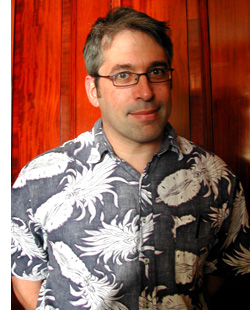 OSA member David Grier talks with Optics & Photonics News about his path to academia—from aspiring historian at Harvard to the chair of NYU’s physics department and Center for Soft Matter Research. Thanks to OSA member Brooke Hester for working with David to gather his insights.
OSA member David Grier talks with Optics & Photonics News about his path to academia—from aspiring historian at Harvard to the chair of NYU’s physics department and Center for Soft Matter Research. Thanks to OSA member Brooke Hester for working with David to gather his insights.
OPN: What was your background prior to becoming a professor?
David: I started college at Harvard assuming that I'd be a historian. Through an advising mishap, I signed up for organic chemistry and multivariable calculus in my freshman year. That was fortuitous because I discovered that I really wanted to be a scientist. I switched to chemistry in my junior year, but then came to realize that I was best suited for physics. Fortunately, the college allowed me to change concentrations yet again.
After Harvard, I went to graduate school in physics at the University of Michigan. I had no real sense of what I wanted to do beyond knowing that I would be an experimentalist. Luckily, I found myself in one of the hot-beds of soft-condensed matter physics in the days before the field even had a name. I liked the people in the field and their style of work, so that set the course for my studies. Because soft-matter was such a new area, the experiments I worked on involved new and unusual techniques. For instance, I was in the first generation of graduate students to be trained in digital image analysis. Having an unusual portfolio of skills probably explains my good fortune in landing a postdoc at AT&T Bell Labs.
OPN: How did you enter academia?
David: I was invited to give a talk at the University of Chicago just as my postdoc was winding up, and I was offered an appointment as an assistant professor not long after. I jumped at the chance even though the move from industry to academia meant a very steep pay cut. After a dozen happy years rising through the ranks at Chicago, I was enticed to New York University by the prospect of helping to start the Center for Soft Matter Research (CSMR). I arrived at NYU as a full professor in 2004 and was appointed chair of the department of physics in 2005. NYU made it possible for me and my colleagues to build the CSMR into a research consortium that bridges physics, optics, chemistry, biology and several branches of engineering.
OPN: What are your current responsibilities?
David: My work week is exceptionally busy. I typically teach one lecture course per term, which takes about 15 hours per week. Teaching used to take longer, but experience helps. I spend between 30 and 40 hours per week on research. That includes working with my students in the lab, analyzing data, writing papers and drafting grant proposals. I also do my fair share of refereeing and spend one day per month on educational outreach.
Not all of my research is done at work. I do a lot of writing at home late at night or early in the morning when my family is asleep. Finally, I have to do a lot of administrative work as chair of the department. The key consideration here is to recruit and retain an excellent staff and to work closely with them to prevent minor issues from developing into major problems. Similarly, forming good faculty committees and providing them with useful oversight ensures that the academic side of the department runs smoothly.
OPN: What advice would you give to others looking to break into academia?
David: Be enthusiastic and articulate. It is also crucial to write quickly and persuasively, since any academic job involves a lot of writing. Successful faculty candidates stand out to search committees because they convey the importance and excitement of their research to people who are not specialists in their field.
However, those characteristics will only get an applicant's foot in the door. To land a job, it is essential to have made progress on an interesting and important problem, to convince other people that your advances are substantial, and to demonstrate unambiguously that you were responsible for the results. It is equally critical to have exciting plans for the future and to communicate them effectively.
During an interview, listen closely to what others say about their own research. Ask questions. Figure out how their work might relate to yours. Make connections. Give your future colleagues lots of reasons to want you around.
The first years in a new faculty position can be daunting. On top of getting everything done, it's exceedingly important to balance research and work with personal life, which for many people means family life. I try to put family at (or at least very near) the top of my list. That means I pay close attention to how I budget my time. Time, it turns out, is your most precious resource.
David Grier (david.grier@nyu.edu) is a professor and chair of the department of physics at New York University. After a postdoc appointment at AT&T Bell Labs, he joined the faculty of Physics at the University of Chicago, where he was a member of the James Franck Institute and Institute for Biophysical Dynamics. Grier moved to NYU in 2004 as a founding member of the Center for Soft Matter Research.
